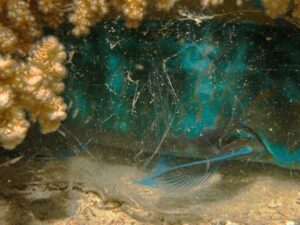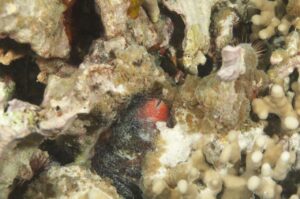Pickholtz, R., Kiflawi, M., Buba, Y., Chaikin, S., Gavriel, T., Lapid, G., Lazarus, M., Malamud, S., Marom, N., Marom, S., Nieger-Rachmilevitz, M., Olssen, K., Perevolotsky, T., Bat-Sheva Rothman, S., Salingré, S., Shapira, N., Sternbach, B., Wandel, H., Belmaker, J. (2023). Confronting the ‘nocturnal problem’ in coral reefs: sleeping site selection and cocoon formation in parrotfishes. Coral Reefs. https://doi.org/10.1007/s00338-023-02389-1
Sleeping slimeballs
Have you ever wondered how fish sleep? If so, you’re in luck – so did a group of researchers! Specifically, they were curious about the sleeping preferences of parrotfish. Parrotfish are one of the most ecologically important animals in coral reef ecosystems. By continuously grazing on algae and coral, they prevent algae from overgrowing and help maintain coral health. They’re also responsible for creating luxurious white sand beaches by breaking down coral into teeny, tiny pieces and pooping it out. A single parrotfish can produce up to 200 pounds of sand per year!
Some parrotfish have a unique sleeping quirk – they sometimes surround themselves in a transparent mucus cocoon. To build the cocoon, they slowly excrete mucus from their mouth. Although the exact function of these cocoons is uncertain, they’re believed to hide the parrotfish’s scent from predators and/or serve as a barrier from parasites. It’s also been suggested that parrotfish may form cocoons under high-stress situations or when they’re injured.
While daytime parrotfish behavior has been widely studied, their sleeping behavior and habitat utilization patterns at nighttime remain poorly understood. Sleeping site selection and the availability of suitable habitats are crucial for an individual’s fitness. Therefore, knowing how parrotfish behave at night – and especially which parts of the reef they utilize – is necessary for effective management strategies centered on parrotfish abundance. To learn more, a team of researchers performed a comprehensive study observing sleeping parrotfish in the wild across multiple species, life stages, and habitats.

Surveying snoozing fishes
The research team conducted their study between February 2020 and August 2021 on a coral reef in the northeastern Gulf of Aqaba, which is at the northern tip of the Red Sea. To observe sleeping parrotfishes, they began their dives at least 30 minutes after sunset. Divers recorded all parrotfishes observed along belt transects (a rectangular area centered on a line) that were 25 meters long and 14 meters wide. For each parrotfish they came across, the following information was recorded: 1. Species; 2. life phase (i.e., juvenile, adult, etcetera); 3. total fish length; 4. depth; 5. time in minutes after sunset; 6. how much the fish was exposed (in percentage) by viewing it from all possible angles; 7. surrounding habitat; 8. yes or no to resting on the seafloor; and 9. yes or no to mucus cocoon presence. If fish were obviously awake or disturbed by the divers, they weren’t recorded. A total of 225 individual parrotfishes from 11 species were observed over the study period.
Sleeping patterns and cocoon formation
The researchers found some variation of sleeping patterns within different parrotfish species. Surprisingly, there were very few disti
nctions in sleeping preferences across fish size and life stage. Most fish were found sleeping close to the seafloor, likely to help reduce predation risk. Swarthy parrotfishes (Scarus niger) and iridescent parrotfishes (Calotomus viridescens), however, were consistently sleeping high above the seafloor and may have alternative means of predator avoidance such as camouflage.

There were huge differences in whether different parrotfish species slept in open or concealed areas. The research team expected most fishes to sleep in concealed areas to hide from predators, and indeed found that most parrotfishes slept below coral or rock shelves and above soft surfaces such as sand. However, some parrotfish species like the bullethead parrotfishes (Chlorurus sordidus) slept half-
exposed (55% body showing), while others like C. viridescens usually slept almost completely exposed (86% body showing). Sleeping in open areas may also reduce predation risk by allowing for earlier warning and/or easier escape. Importantly, it seems that high structural complexity (meaning habitats with lots of crevices) for nighttime shelter isn’t critical for parrotfish when selecting a habitat.
In terms of cocoon formation, there was also wide diversity among and within species. It appears that cocoon formation may be optional (referred to in biology as facultative) and limited to certain parrotfish genera including Chlorurus and Scarus. Although the researchers hypothesized that fishes would be more likely to form a cocoon if they were sleeping in a more exposed area, this wasn’t the case. In fact, only 10 out of the 225 fish surveyed had formed a cocoon and the presence of cocoons wasn’t explained by any environmental factors such as site complexity or habitat type.

So what?
Interestingly, this is the first study to characterize sleeping patterns of parrotfish in the wild across species, life history traits, and habitats. Sleeping site selection has a huge impact on movement patterns and animal fitness by providing protection from predators. Since parrotfish are key players in coral reef health and resilience, understanding their habitat use patterns during the daytime and nighttime is critical for successful reef management and conservation strategies targeting this important guild. While this study uncovered substantial patterns in nighttime habitat selection, more research is required to further understand links between parrotfish cocoon formation and environmental factors.
Cover photo by François Libert, CC BY-NC-SA 2.0.

I’m an MSc student in marine biology at the University of Hawaiʻi at Mānoa. I conduct research through the Johansen Fish Resilience Lab at the Hawaiʻi Institute of Marine Biology. I’m currently studying the effects of sedimentation on the foraging behavior of herbivorous coral reef fish. Before grad school, I got a double BS in environmental geology and environmental studies at Tufts University before working at a shark research lab in the Bahamas. In my free time, you can find me climbing, running, or reading at the beach.

